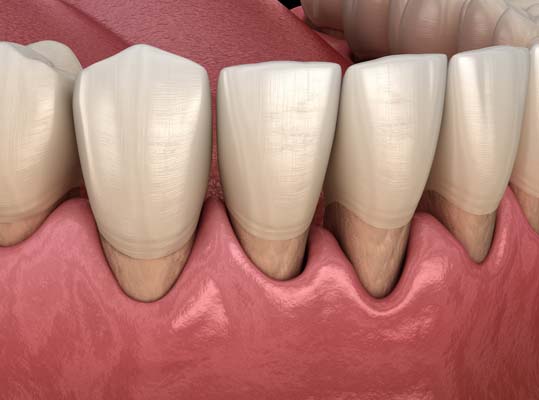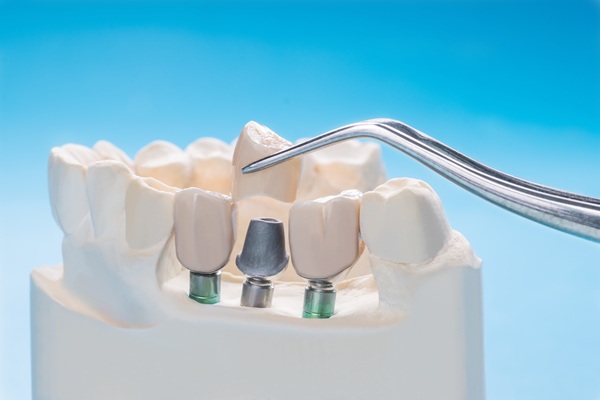Peridontist Treatment for Gum Recession

Gum recession is often the result of a severe infection in the soft tissues of the oral cavity, but fortunately, a periodontist can treat the condition in a couple of different ways. While treatment may seem daunting, the condition will only worsen if left untreated. Keep reading to learn more about the available treatment options.
How a periodontist treats gum recession
The following information highlights how a periodontist treats gum recession.
Scaling and root planing
When gum recession is at a minor stage, periodontists often recommend a scaling and root planing procedure. Scaling and root planing is also referred to as a deep dental cleaning, which targets the gum tissue. The goal of this procedure is to make gum pockets smaller in size. Doing this ultimately helps with gum recession.
During a scaling and root planing procedure, the patient can expect their mouth to be numbed so there is not any discomfort. The periodontist then pulls back the gumline and clears out the roots, ensuring no build-up is left behind.
The procedure typically takes an hour to two hours. In severe cases, the dentist might recommend doing one arch in one appointment and the other in another appointment. This reduces the amount of stress that is put on the mouth.
Gum grafting
When gum recession is moderate to severe, a simple scaling and root planing procedure might not be effective. It will still be helpful and even beneficial to the health of the gums, but more serious attention might be necessary. In this case, the periodontist might recommend gum grafting. A gum grafting procedure is more in-depth because it requires oral surgery.
During a gum grafting procedure, the periodontist might bring in the help of an oral surgeon for extra support. Typically, this process takes around two hours to complete because tissue from another area of the mouth has to be removed and then placed along the targeted gumline.
Avoiding gum recession
Although gum recession is treatable by a periodontist, it is advised for patients to seek ways to avoid the condition altogether. Periodontists can provide many resources to help prevent gum recession, including:
- Regularly seeing a dental office for routine cleanings
- Flossing once a day and gently brushing twice a day or after every meal
- Avoiding foods and beverages that are highly acidic or sugary
- Considering a medicated rinse or toothpaste to help prevent any build-up along the gumline
When consulting with a periodontist, patients can ask for specialized recommendations on keeping the gums in good shape.
Talk to a periodontist today
When suffering from gum recession, it is ideal to consult with a periodontist right away. A consultation enables the periodontist to evaluate how severe the patient's condition is, so they can determine what type of treatment is needed. Additionally, patients can ask questions and go over any existing concerns. To learn more about gum recession and how it is treated, reach out today.
Request an appointment here: https://www.periocafe.com or call Brighton Periodontal & Implant Dental Group at (818) 703-7733 for an appointment in our Woodland Hills office.
Check out what others are saying about our services on Yelp: Read our Yelp reviews.
Recent Posts
All-on-4 dental implants provide a stable, long-lasting solution for individuals who have lost most or all of their teeth. This advanced treatment approach allows patients to regain both the function and appearance of a natural smile. By strategically placing four dental implants in the jaw, a full arch of prosthetic teeth can be securely supported…
Dental implants are the gold standard of dental replacements. Titanium rods and porcelain crowns are the most stable dental replacements you can get. Once osseointegration ends, you will have a strong, stunning smile again. Knowing the advantages of dental implants can motivate you to see your dentist about getting these restorations. Here are the three…
Implant supported dentures are a reliable and long-lasting solution for individuals who need to replace most or all of their teeth. Unlike traditional dentures that rest on top of the gums, implant supported dentures are anchored by dental implants that are surgically placed into the jawbone. This method offers increased stability, improved function, and a…
A prosthodontist is a type of dental specialist who can provide a range of treatments within a single smile makeover plan. Due to their advanced education and training, they are an ideal solution if you are looking for a professional who can reliably help you reach your cosmetic and oral health goals.A smile makeover involves…


